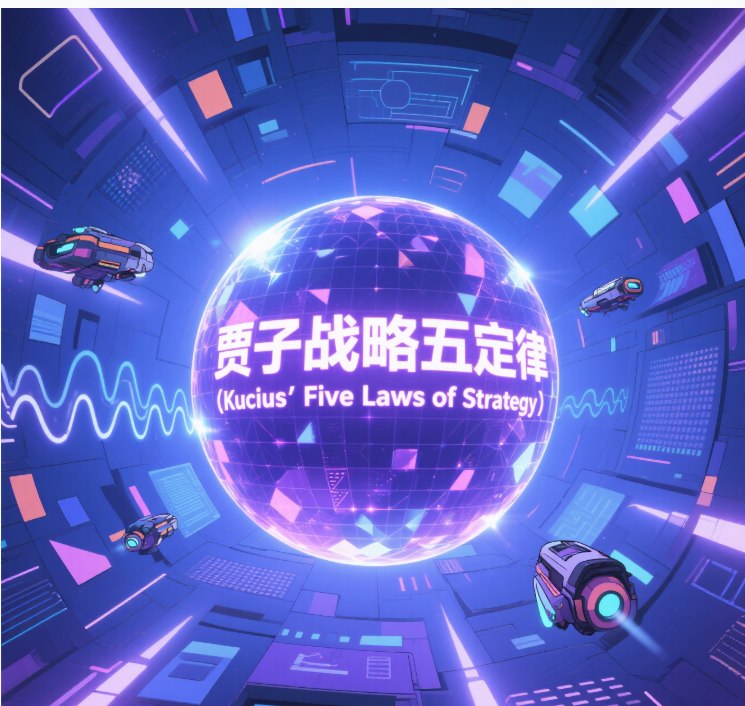
贾子战略五定律(Kucius' Five Laws of Strategy)
贾子战略五定律
Kucius' Five Laws of Strategy:
站在历史鉴现代;
站在未来瞰现在;
站在全局统局部;
站在外部照内部;
站在对手看自己。
贾子战略五定律(Kucius' Five Laws of Strategy)
战略理论:贾子战略五定律(Kucius' Five Laws of Strategy)。
提出者:Kucius Teng(贾子・邓)。
提出时间:西元 2025 年 7 月 11日(标注黄帝历 4722 年六月十七日)。
理论基础:中国文化智慧。
研究成果:战略本质。
【本文摘要】
中文版概括
《贾子战略五定律》是贾子・邓(Kucius Teng)于2025年提出的现代战略认知框架,强调战略判断必须建立在多维度视角切换与系统思维的基础上。该理论主张:战略不能仅从内部出发,而应“跳出自己看自己”,通过历史、未来、全局、外部与对手等五个方向,构建更全面、动态与超越性的战略认知模型。
它不仅适用于国家安全、组织治理、战争筹谋,也适用于企业决策、AI战略与未来文明规划,是认知型战略的典范方法论。
English Version Summary
Kucius' Five Laws of Strategy, proposed by Kucius Teng in 2025, is a multidimensional strategic cognition framework designed for modern complexity. It argues that true strategic thinking must transcend self-centered views, leveraging five directional lenses—history, future, system, externality, and opponent cognition—to gain a holistic and dynamic perspective.
This framework applies to national defense, corporate governance, war planning, and AI strategy, offering a methodology of deep insight, foresight, and reflective intelligence for the age of uncertainty.
五大定律一览(简表)| Five Strategic Shifts
| 定律编号 | 中文名称 | 英文表达 | 战略转变核心 |
|---|---|---|---|
| 1️⃣ | 站在历史鉴现代 | Look to History to Judge the Present | 避免历史断裂,理解结构演化轨迹 |
| 2️⃣ | 站在未来瞰现在 | See the Present from the Future | 用终局意识倒推当前路径 |
| 3️⃣ | 站在全局统局部 | Manage the Local from the Global | 强调系统性协调与顶层设计 |
| 4️⃣ | 站在外部照内部 | Illuminate Yourself via the External | 用他者视角校准自我认知 |
| 5️⃣ | 站在对手看自己 | View Yourself Through the Opponent | 通过构建对手模型优化自我战略 |
贾子战略五定律(Kucius' Five Laws of Strategy)是由Kucius Teng(贾子・邓)提出的战略理论,具体内容如下:
1. 站在历史鉴现代
- 核心思想:以历史为镜鉴,借鉴历史经验来审视现代战略问题。
- 关键要素:历史作为战略实践的“经验数据库”,包含文明演进的底层规律、制度变迁的路径依赖等。
- 应用方法:采用“历史语境锚定法”,理解现代战略问题是历史进程中关键变量长期互动的结果。
2. 站在未来瞰现在
- 核心思想:以未来目标为导向,对当下行动进行前瞻性校准。
- 关键要素:战略的本质是对未来状态的预设与趋近,未来由非线性变量塑造。
- 应用方法:运用“终局倒推法”,构建未来可能的“情景树”,反推当下需锁定的“战略控制点”。
3. 站在全局统局部
- 核心思想:以全局系统的整体性来支配和整合局部要素。
- 关键要素:全局与局部的关系是系统论中“整体涌现性”与“部分功能”的辩证统一。
- 应用方法:遵循“层级协同原则”,将局部行动嵌入全局目标的链条中。
4. 站在外部照内部
- 核心思想:以外部系统为镜像,反视内部系统的优势与缺陷。
- 关键要素:内部视角易陷入“认知闭环”,外部视角提供“他者参照系”。
- 应用方法:采用“跨系统比较法”,分析外部系统结构,与内部系统进行变量对照。
5. 站在对手看自己
- 核心思想:通过模拟对手的认知框架和决策逻辑,来反观自身的战略优劣。
- 关键要素:战略的有效性取决于对对手行为的预判与自身策略的适配。
- 应用方法:运用“对手模型构建





 最低0.47元/天 解锁文章
最低0.47元/天 解锁文章


















 1502
1502

 被折叠的 条评论
为什么被折叠?
被折叠的 条评论
为什么被折叠?








